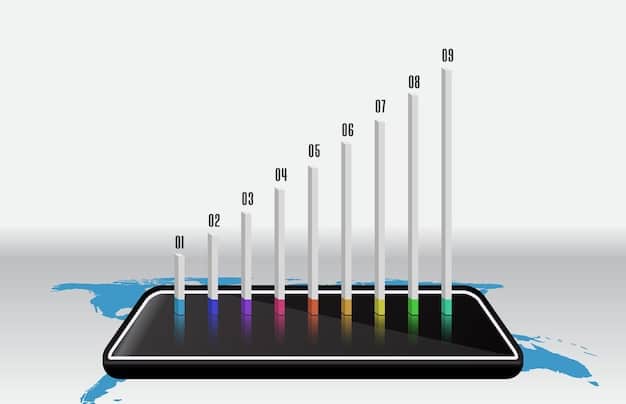Social Media for Small Businesses: Your 2025 Guide

Social Media for Small Businesses: A Practical Guide to Getting Started in 2025 equips entrepreneurs with the knowledge and strategies to navigate the evolving social media landscape, build a strong online presence, and connect with their target audience effectively.
Navigating the world of social media for small businesses: a practical guide to getting started in 2025 can feel overwhelming. But, with a clear strategy and the right tools, you can harness the power of social media to grow your business and connect with customers in meaningful ways.
Why Social Media Matters for Small Businesses in 2025
In 2025, social media remains a crucial tool for small businesses. It’s not just about posting updates; it’s about building relationships, establishing brand authority, and driving sales.
Reach a Wider Audience
With billions of users worldwide, social media platforms offer unparalleled opportunities to reach potential customers beyond your local area. Targeted advertising and engaging content can help you connect with the right people.
Build Brand Awareness
Consistent social media activity helps build brand recognition and establishes your business as a thought leader in your industry. Sharing valuable content and interacting with your audience fosters trust and loyalty.

Key benefits of Social Media for Small Businesses in 2025:
- Enhanced Brand Visibility: Increase brand recognition through consistent content sharing and engagement.
- Improved Customer Engagement: Foster direct communication with customers, leading to stronger relationships.
- Targeted Advertising: Reach specific demographics and interests with tailored social media ads.
- Valuable Insights: Gain data-driven insights into customer behavior and preferences.
Social media is no longer optional; it’s an essential component of a successful small business marketing strategy.
Choosing the Right Social Media Platforms
Not all social media platforms are created equal. The best platform for your business depends on your target audience, industry, and marketing goals. Focus on platforms where your ideal customers spend their time.
Facebook remains a dominant platform for reaching a broad audience. It’s suitable for businesses targeting a wide range of demographics and offering diverse products or services.
Instagram is ideal for visually-driven businesses, such as those in the fashion, food, or travel industries. High-quality images and videos are key to success on this platform.
LinkedIn is the go-to platform for B2B businesses and professionals. It’s excellent for networking, generating leads, and establishing thought leadership.
TikTok
TikTok is popular among younger audiences and is ideal for short-form video content. It’s suitable for businesses that can create engaging and entertaining videos.
X (formerly Twitter)
X is useful for sharing quick updates, news, and engaging in real-time conversations. It’s valuable for customer service and brand monitoring.
Selecting the right social media platforms ensures you’re directing your efforts where they’ll have the most significant impact.
Developing a Social Media Strategy for 2025
A well-defined social media strategy is crucial for achieving your business goals. Without a plan, your efforts may be scattered and ineffective. Define your objectives, target audience, and content strategy.
Set Clear Goals
What do you want to achieve with social media? Do you want to increase brand awareness, generate leads, or drive sales? Define specific, measurable, achievable, relevant, and time-bound (SMART) goals.
Know Your Audience
Understand your target audience’s demographics, interests, and behaviors. This information will help you create content that resonates with them and choose the right platforms.
Essential Steps for Creating a Social Media Strategy in 2025:
- Conduct Market Research: Understand industry trends and competitor strategies.
- Outline a Content Calendar: Plan posts in advance to maintain consistency.
- Allocate Budget for Paid Advertising: Invest in targeted social media ads.
- Monitor and Analyze Performance: Track key metrics and refine your approach.
A strategic approach to social media ensures your efforts are aligned with your business objectives.
Content Creation: Engaging Your Audience
High-quality content is the cornerstone of a successful social media presence. Create content that’s valuable, informative, and engaging for your target audience. Vary your content types and experiment with different formats.

Types of Content
Some examples include blog posts, videos, infographics, images, stories, live streams, and polls. Tailor your content to the preferences of your target audience and the capabilities of each platform.
Content Pillars
Develop content pillars around key themes related to your business and industry. This helps you stay organized and ensures your content is relevant and consistent.
User-Generated Content
Encourage your audience to create and share content related to your business. User-generated content can be a powerful form of social proof and can help build community.
Content Ideas for Social Media in 2025:
- Behind-the-Scenes Content: Showcase your company culture and team members.
- Educational Tutorials: Provide how-to guides related to your products or services.
- Customer Testimonials: Share positive feedback from satisfied customers.
- Interactive Q&A Sessions: Host live sessions to answer audience questions.
Creating compelling content is essential to capturing and retaining your audience’s attention.
Social Media Advertising: Reaching Your Target Audience
Social media advertising allows you to reach a highly targeted audience and drive specific actions, such as website visits, lead generation, or sales. Utilize targeting options and create compelling ad creatives.
Targeting Options
Social media platforms offer a wide range of targeting options, including demographics, interests, behaviors, and location.
Ad Formats
Experiment with different ad formats, such as image ads, video ads, carousel ads, and lead generation ads. Choose the format that best suits your message and target audience.
Social Media Management Tools
Managing multiple social media accounts can be time-consuming. Social media management tools can help you streamline your workflows, schedule posts, and track your performance.
Popular Social Media Management Tools for 2025:
- Hootsuite: A comprehensive platform for scheduling and managing social media content.
- Buffer: A user-friendly tool for scheduling posts and analyzing performance.
- Sprout Social: A robust platform for social listening, engagement, and analytics.
- Later: A visual planning tool designed for Instagram.
Leveraging social media management tools can significantly improve your efficiency and effectiveness.
| Key Point | Brief Description |
|---|---|
| 🎯 Define Goals | Establish SMART goals to guide your social media efforts effectively. |
| 📊 Track Metrics | Monitor performance to refine strategies and maximize ROI. |
| 📱 Choose Platforms | Select platforms aligned with your target audience and business goals. |
| ✍️ Create Content | Develop engaging, informative content to capture audience attention and build trust. |
Frequently Asked Questions
▼
Focus on platforms where your target audience spends the most time. Consider demographics, interests, and content preferences when making your choice. Facebook, Instagram, LinkedIn, and TikTok are popular options.
▼
Consistency is key. Aim to post regularly, but avoid overwhelming your audience. Experiment with different posting schedules to find what works best for each platform.
▼
Engaging visual content, such as videos and images, tends to perform well. Also, educational tutorials, behind-the-scenes content, and user-generated content can resonate with your audience.
▼
Track key metrics such as engagement rate, reach, website traffic, and lead generation. Use social media analytics tools to monitor your performance and make data-driven decisions.
▼
Paid social media advertising can be highly effective for reaching a targeted audience and driving specific actions. Set a budget, experiment with different ad formats, and monitor your ROI.
Conclusion
By implementing these strategies, small businesses can effectively utilize social media to build brand awareness, engage with customers, and drive business growth in 2025. Stay adaptable and continuously refine your approach based on data and trends.





